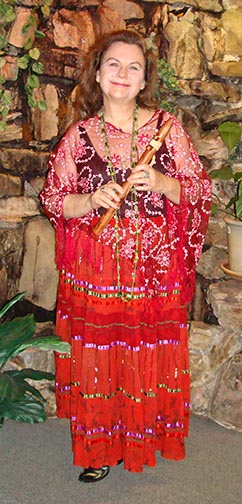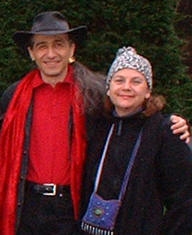The Grapevine Art & Soul Salon
Presentations: Sandra Lee Hughes

Sandra Lee Hughes is an international professional teaching artist, performer, director and choreographer and the Founding Artistic Director of Gateway Performance Productions, the company in residence at The MASK Center in Atlanta (www.masktheatre.org).
Moved by the Bees
A CHILDHOOD MEMORY
When the clover bloomed in my backyard with stems so fragile they could hardly bear the weight of the delicate white blossoms that vibrated ever so slightly in the breeze, I’d touch my tongue to the dainty white-feathered petals to taste the ephemeral sweetness that lingered there. I’d note the presence of honeybees deeply engaged in their own communion with these humble flowers, find a mason jar, punch holes in its metal lid, and place a cushion of green grass with clover heads in the bottom of the jar. Then I’d remove my sneakers and begin a barefoot dance in a slow, spiral motion. When my playmates saw me do this, they instinctively stopped their activities, moved out of the way and sat expectantly at a distance. A few ran to gather other youngsters, to invite them to bear witness to my curious rite.
My dance brought me into direct contact with a honeybee. Once I identified my honeybee partner, I’d bend over, gently lift her up, place her in the jar and tighten the lid. The other children silently passed the jar from hand to hand. When the circuit was completed, I’d remove the lid and place the jar on the grass. Children fled in all directions. I ran, too, even though I wasn’t afraid of the bee. We ran so far away that it was impossible to see when the bee flew out of the jar. We fled, found safety, and that was the end of it. My actions were the catalyst that allowed us to find communal relief at the end of our flight. The bee initiated us into a rite that connected us to the underlying richness of our existence.

Atlanta nature photographer Michael Birnbaum recently gifted me with a copy of his award-winning photograph Kissing Bees (used here by permission of the photographer). According to Michael, the two honeybees he’d photographed walked in opposite directions and spiraled towards each other until they met. The nectar-carrying device called a proboscis of one was inserted into the mouth-like orifice of the other. At the apex of their interchange, Michael took the photo. The spiral movements of the Kissing Bees recall my own childhood dance with a honeybee.
HONEYBEE EVOLUTION
The most arcane stories say the honeybee came to Earth from Venus. Scientists tell us the bee evolved here on this planet and preceded humankind by 10 to 20 million years. The honeybee, an insect with a brain the size of a grain of sand, has incredible abilities. Science is only beginning to grasp the complexities contained in this miraculous example of evolutionary persistence.

Recently, an ancient fossil emerged in Northern Myanmar (formerly the country of Burma) to reveal a 100 million-year-old precursor of the honeybee. The honeybee is believed to have evolved from the wasp. The amber-encased insect seems to share characteristics with both the pollen-dependent bee and carnivorous wasp ancestors. Experts agree this specimen is more bee than wasp and offers a clear perspective on how the two types of insects managed to separate on their evolutionary paths
The bees left the ancient conifer forests to create a lifestyle based on the pollination of flowers. The honeybee transformed our earthly home into a garden of paradise. The short ecstatic existence of the honeybee is full of fragrance, beauty and the metamorphosis of faded flowers into fruits, nuts and vegetables. The honeybee midwifes some of our most delicious edibles into existence, foods that now add vital nutritional elements to the human diet.
BEES ON THE MOVE
At one time honeybees were thought to have first appeared in Asia. Once the bee became the fourth insect to have its DNA sequenced, it was determined that the honeybee, like humans, arose in Africa and then traveled into Europe.

Itinerant beekeepers in Lower Egypt loaded their wicker hives covered with clay onto boats and traveled north to pollinate flowering plants. Aristaeus, the Greek patron of agriculture and especially beekeeping, was constantly on the move. Wherever he traveled in the ancient world, Aristaeus took his honeybees with him.

The extraordinary evolutionary emergence of the honeybee took place far away from my hometown. That I was able to dance with a honeybee at all is a bit of a geographic miracle, as honeybees are not indigenous to North America. All the honeybees in the Americas were moved here by humans and are relative newcomers. Settlers first brought a western European subspecies in 1622. A Mediterranean subspecies was imported in the mid-1800s and an African subspecies was brought to Brazil in 1956. Today, honeybees pollinate many of the crops that comprise the current food supply in the United States. A vast migratory bee industry moves honeybees from place to place in an attempt to address the human need for food.
COLONY COLLAPSE DISORDER
In February 2007, Colony Collapse Disorder (the die-off of members of a honeybee hive) suddenly struck commercial hives in the United States. According to a government report released in March of the same year, CCD affected 27 states and their crops. Some commercial beekeepers lost 80% of their hives. The cause of this massive die-off is currently unknown. A number of possible factors are suspected, such as mites, beetles and pesticides. A profile of human interference with honeybee life has emerged that some observers believe contributes to the current collapse of our commercial hives. These factors include moving hives over long distances and transferring larva to artificial cups and then to cages for transport, as well as clipping the wings of queen bees.
FINDHORN
I first learned the honeybees on our planet were dying in vast numbers in January 2006 at the Findhorn Foundation in Scotland. Findhorn is a non-governmental organization associated with the United Nations Department of Public Information that takes an active role at U.N. headquarters in New York, especially in the areas of education, environmental sustainability, and values.

A Ford Foundation grant received through Alternate ROOTS made it possible for me to teach, perform and attend Findhorn faculty member Franco Santoro’s workshop, Manifesting Honorable Intentions – Healing the Planet from the Inside Out. During Franco’s workshop, I worked with Findhorn beekeeper Sverre Koxvold. Sverre told workshop participants that all the wild bees in Scotland were dead and enlisted our assistance to level the side of a Scottish hill in order to position a specially designed platform to protect his bees from the deadly varroa mite. Sverre also requested I play my Native American flute to accompany this effort.

THE BEE PROJECT
In the United States, where one of every three bites we eat is attributed directly to honeybee activity, and two of every three bites to their contribution to the survival of the animals many of us consume, the death of the bees provides a startling wakeup call.
My work with Franco and Sverre at Findhorn moved me to design, develop and offer a variety of arts and education programs to raise awareness of the current planet-wide plight of the honeybee. These include residencies, workshops, performances and power point talks. More information on these programs and other related resources is available at www.thebeeproject.org.
It’s my hope that together we’ll discover effective actions to take on behalf of the honeybee population, our own species and the planet Earth. In this way we can continue to participate in the creative cooperation that moves throughout the cosmos and is reflected in the spiral dances of humans and honeybees.
More on Sandra...
Articles written by Sandra have appeared in the Atlanta Journal Constitution, Cleveland Plain Dealer, and the Atlantic Celtic Quarterly. Her Holiday Special written for WVIZ Public Televison received national distribution and a regional EMMY for "Outstanding Entertainment Program of the Year." Bring Me Yellow Flowers, Sandra's tribute to Mexican visual artist Frida Kahlo, showcased at the American Film Institute Video Festival in Los Angeles and was nominated for the Robert Bennet Award. Her radio play, The Final Draft, received a grant award from the Fulton County Arts Council in Atlanta and was broadcast on WABE Public Radio in Atlanta and KSFR Public Radio in Santa Fe, New Mexico. Sandra's plays for live stage and educational venues have been presented nationally and internationally and received developmental support and awards from the Southeast Playwrights Project and the Santa Fe Playwrights Lab. Four of her plays based on the Irish Mummer Tradition premiered in Northern Ireland; the others premiered at Atlanta Celtic Christmas and The MASK Center in Atlanta. Sandra's plays based on and inspired by the Irish mummer tradition are included in the Irish Theatre Collection housed at Ohio State University as items of significant cultural value. Sandra has also received two grant awards from the Georgia Council for the Arts for playwrighting, has won the first place award at the Desert Playfest and has been awarded three residency fellowships for writing at the Hambidge Center for the Arts and Sciences in Georgia.